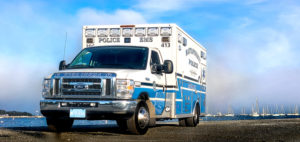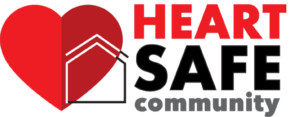 The Mattapoisett Police Emergency Medical Service provides emergency Advanced Life Support via two Class 1 ambulances. The service is comprised of 8 Paramedics, 3 of which are also full-time Police Officers. The department is also staffed with 19 Police Officers trained to the level of basic EMT, and paramedic assist.
The Mattapoisett Police Emergency Medical Service provides emergency Advanced Life Support via two Class 1 ambulances. The service is comprised of 8 Paramedics, 3 of which are also full-time Police Officers. The department is also staffed with 19 Police Officers trained to the level of basic EMT, and paramedic assist.
Mattapoisett Named as a HeartSafe Community!
You Live in a Heartsafe Community!
- If someone in your community suffers a sudden cardiac arrest tomorrow, how likely is he or she to survive due to rapid access to life-saving treatment?
- Now that all cities and towns in Massachusetts have enhanced 9-1-1, how many residents and public safety officials in your community can recognize the symptoms of cardiac arrest and know how to get help “on the way, right away”?
- Who knows CPR in your community and is prepared to administer it when necessary?
- Where are automated external defibrillators (AEDs) located, and who has been trained to use them appropriately?
The Massachusetts Department of Public Health, through its Office of Emergency Medical Services (OEMS) and the American Heart Association, aim to help the Commonwealth’s cities and towns improve the chances that anyone suffering a sudden cardiac arrest will have the best possible chance for survival.
Through the HeartSafe Community program, Massachusetts communities can strengthen what the American Heart Association has called the “chain of survival,” which has four critical steps:
- Early access to emergency care
- Bystanders recognize the symptoms of cardiac arrest and call 9-1-1 immediately.
- EMS dispatchers are equipped with instructions for the caller and can get an Advanced Life Support response vehicle to the scene quickly.
- Early CPR
- CPR, when properly administered, buys precious minutes until a defibrillator is available.
- Public knowledge and awareness must be increased so that those trained in CPR will actually use it when it is needed.
- Early defibrillation
- Defibrillation is the delivery of an electric shock to restore the heart’s normal rhythm.
- Early defibrillation is considered to be the most critical link in the chain of survival.
- New AEDs are light-weight, sturdy, and easy to use by anyone who has been trained.
- AEDs should only be used by individuals certified by defibrillation training programs that have medical oversight and are coordinated with EMS.
- Early advanced care
- Advanced care is delivered by an Advanced Life Support response vehicle staffed by paramedics.
- Medications and oxygen therapy delivered by paramedics can be critical to the survival of cardiac arrest victims.
What is an E.M.T.?
People’s lives often depend on the quick reaction and competent care of emergency medical technicians (EMTs) and paramedics, EMTs with additional advanced training to perform more difficult pre-hospital medical procedures. Incidents, as varied as automobile accidents, heart attacks, drownings, childbirth, and gunshot wounds all, require immediate medical attention. EMTs and paramedics provide this vital attention as they care for and transport the sick or injured to a medical facility.
Depending on the nature of the emergency, EMTs and paramedics typically are dispatched to the scene by a 911 operator and often work with police and fire department personnel. Once they arrive, they determine the nature and extent of the patient’s condition while trying to ascertain whether the patient has preexisting medical problems. Following strict rules and guidelines, they give appropriate emergency care and, when necessary, transport the patient. Some paramedics are trained to treat patients with minor injuries on the scene of an accident or at their home without transporting them to a medical facility. Emergency treatments for more complicated problems are carried out under the direction of medical doctors by radio preceding or during transport.
EMTs and paramedics may use special equipment such as backboards to immobilize patients before placing them on stretchers and securing them in the ambulance for transport to a medical facility. Usually, one EMT or paramedic drives while the other monitors the patient’s vital signs and gives additional care as needed. Some EMTs work as part of the flight crew of helicopters that transport critically ill or injured patients to hospital trauma centers.
At the medical facility, EMTs and paramedics help transfer patients to the emergency department, report their observations and actions to staff, and may provide additional emergency treatment. After each run, EMTs, and paramedics replace used supplies and check equipment. If a transported patient had a contagious disease, EMTs and paramedics would decontaminate the interior of the ambulance and report cases to the proper authorities.
Beyond these general duties, the specific responsibilities of EMTs and paramedics depend on their level of qualification and training. To determine this, the National Registry of Emergency Medical Technicians (NREMT) registers emergency medical service (EMS) providers at four levels: First Responder, EMT-Basic, EMT-Intermediate, and EMT-Paramedic. In Massachusetts, you must be certified through the State, since they do not accept the National Certification. Many paramedics are certified both nationally and through the State in order to work in other states.
The lowest level-First Responders are trained to provide basic emergency medical care because they tend to be the first persons to arrive at the scene of an incident. Many firefighters, police officers, and other emergency workers have this level of training. The EMT-Basic represents the first component of the emergency medical technician system. An EMT-B is trained to care for patients on accident scenes and transport by ambulance to the hospital under medical direction. The EMT-B has the emergency skills to assess a patient’s condition and manage respiratory, cardiac and trauma emergencies.
The EMT-Intermediate has more advanced training that allows administration of intravenous fluids, use of semi-automatic defibrillators to give lifesaving shocks to a stopped heart, and use of advanced airway techniques and equipment to assist patient experiencing respiratory emergencies.
EMT-Paramedics provide the most extensive pre-hospital care. In addition to the procedures already described, paramedics may administer drugs orally and intravenous, interpret electrocardiograms (EKGs), perform endotracheal intubations, and use monitors and other complex equipment.
Mattapoisett Police E.M.S. Staff & Email
| E.M.S. Coordinator | |
| Lieutenant Scott Leblanc | sleblanc@mattapoisettpolice.gov |
| E.M.S. Manager | |
| Paramedic Kevin Leblanc | kleblanc@mattapoisettpolice.gov |
| Paramedics | |
| Lieutenant Scott Leblanc | sleblanc@mattapoisettpolice.gov |
| Detective Dennis Tavares | dtavares@mattapoisettpolice.gov |
| Officer Paul Andrews | pandrews@mattapoisettpolice.gov |
| Paramedic Kevin Porter | kporter@mattapoisettpolice.gov |
| Paramedic Rick Scherbarth | |
| Paramedic Giovanni Rodriguez | |
| Paramedic Michael Florio | |
| Paramedic Joshua Adams | |
| Paramedic Kevin Gonsalves | |
| Paramedic Peter Lapan | |
| Paramedic Brad Allen | |
| EMTs | |
| Chief Jason King | jaking@mattapoisettpolice.gov |
| Sergeant Robert Dumas | rdumas@mattapoisettpolice.gov |
| Lieutenant Justin King | juking@mattapoisettpolice.gov |
| Officer William Mcilmail | wmcilmail@mattapoisettpolice.gov |
| Sergeant Robert Randall | rrandall@mattapoisettpolice.gov |
| Officer Lenira Lima | llima@mattapoisettpolice.gov |
| Officer Brett Osetkowski | bosetkowski@mattapoisettpolice.gov |
| Officer Sean Parker | sparker@mattapoisettpolice.gov |
| Sergeant Adalberto Cardoso Jr. | acardoso@mattapoisettpolice.gov |
| Officer Kristen Borges | kborges@mattapoisettpolice.gov |
| Officer Ross Lacasse | rlacasse@mattapoisettpolice.gov |
| Officer Felix Perez | fperez@mattapoisettpolice.gov |
| Detective Aaron Bates | abates@mattapoisettpolice.gov |
| Officer Matthew Myers | mmyers@mattapoisettpolice.gov |
| Officer Luis DaSilva | ldasilva@mattapoisettpolice.gov |
| Officer Benjamin Church | bchurch@mattapoisettpolice.gov |
| Officer Jessica Desjardins | jdesjardins@mattapoisettpolice.gov |
| Officer George Kirby | gkirby@mattapoisettpolice.gov |
| Officer Jacob Fluegel | jfluegel@mattapoisettpolice.gov |
| Officer Donna Wunschel | dwunschel@mattapoisettpolice.gov |
Click a link above for more info




